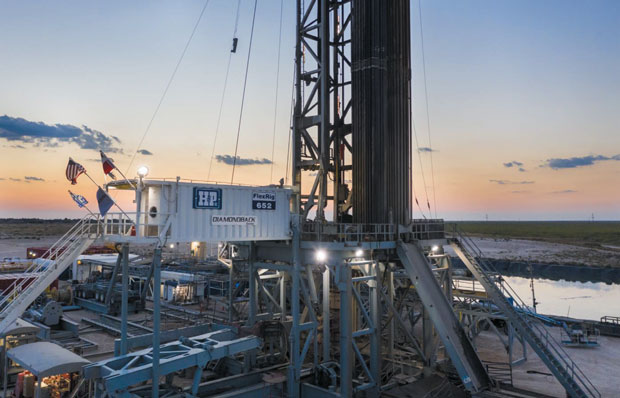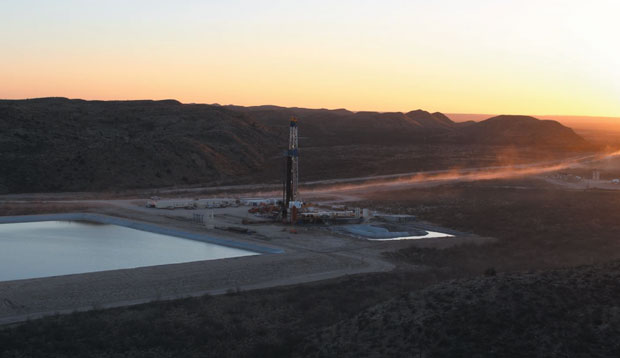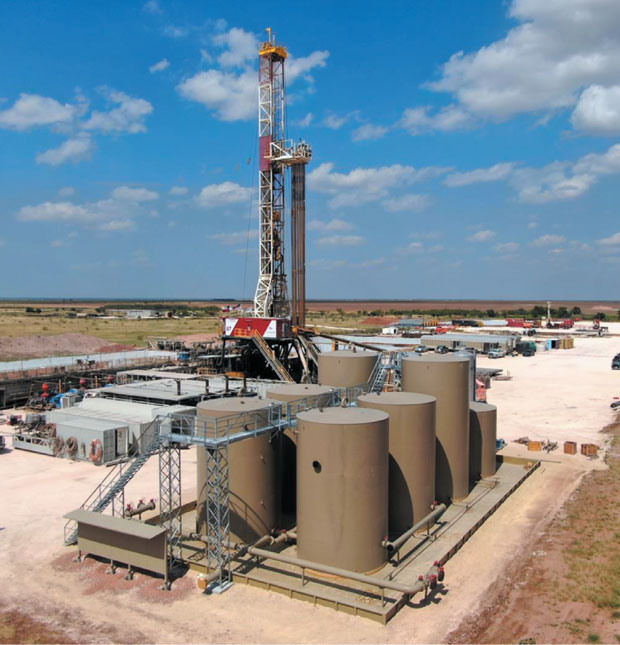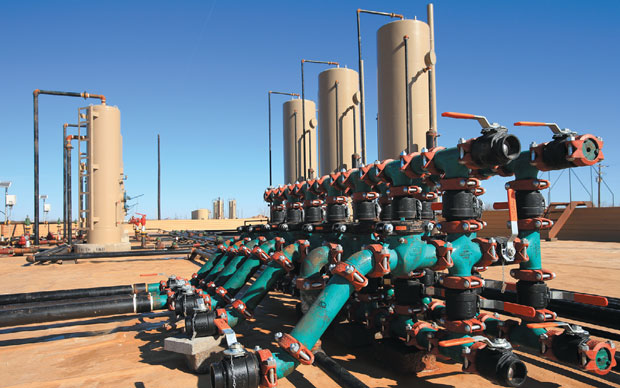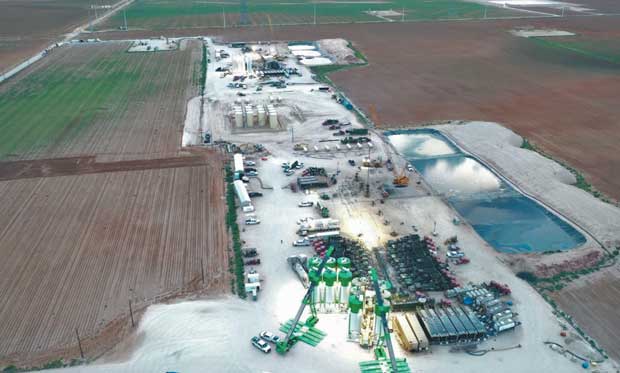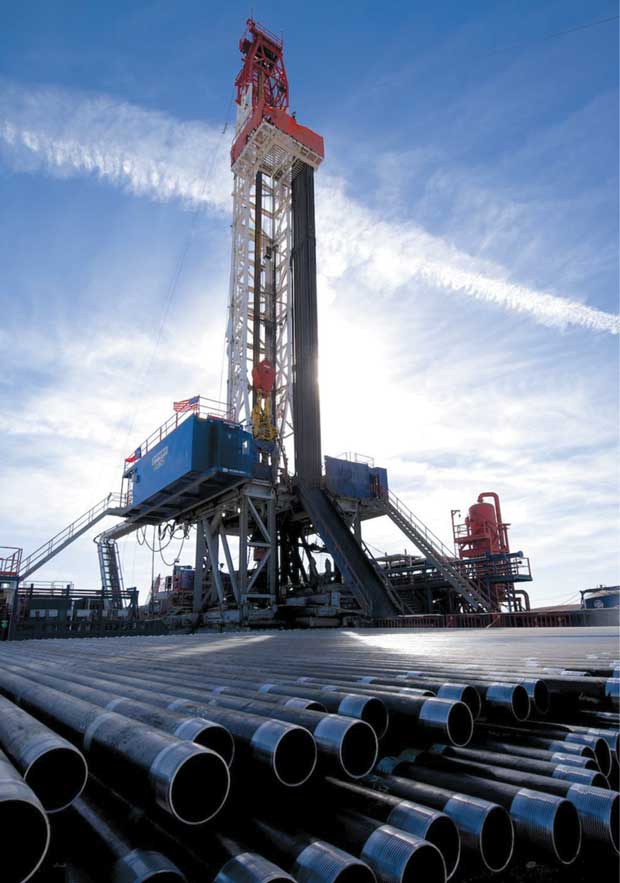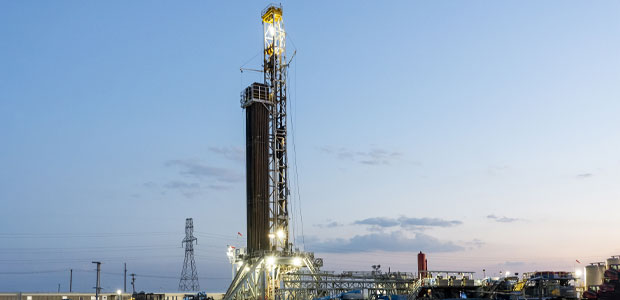
Strong Prices, Huge Inventories Give Operators Running Room In Permian Stacked Plays
By Danny Boyd, Special Correspondent
This year, the Midland Basin will account for 75% of the 210-220 gross wells the company expects to drill and 265-275 gross horizontal well completions. Much of the work is in Martin County, Tx., Van’t Hof explains, where the company is targeting the middle and lower Spraberry as well as the Wolfcamp A and B benches, but also has completed good wells in the shallower Jo Mill. In the Delaware, the company is drilling the Wolfcamp A and B and second and third Bone Spring in Texas’ Pecos and Reeves counties.
Throughout the Permian, Diamondback is running nine rigs and three simulfrac crews. Frac designs typically include 1,500-2,000 pounds of proppant and 45-55 barrels of fluid per lateral foot. Average lateral lengths are 10,300 feet, although Van’t Hof reveals the company has drilled multiple 15,000-foot laterals and says “an efficient frontier” could be around 12,500 feet.
Midland Basin initial well productivities typically average inital production rates of 2,000-2,500 barrels of oil equivalent a day, but he says Diamondback looks chiefly at estimated ultimate recovery per foot as the defining productivity metric, and targets wells that produce 70-90 barrels of oil per foot over their life cycles.
For 2021, the company has increased overall oil production guidance to 219,000-222,000 bbl/d, or 363,000-370,000 boe/d. Capital expenditures this year are in the $1.525 billion-$1.625 billion range. Van’t Hof says Diamondback plans to hold oil production flat for the foreseeable future with the global oil market still artificially undersupplied.
Diamondback Energy is sharpening its position as a pure-play Permian company by allocating a majority of capital to the high-returning Midland Basin while continuing to seek attractive bolt-on acquisitions basinwide. Over the past eight years, that strategy has vaulted Diamondback from a small public company into one of the Permian’s largest.
“If we are sitting here in a year and OPEC production has come fully back on line and oil prices have hung in there and you see a response on the back end of the curve, maybe you have a discussion on production growth, but there are 4 million-5 million barrels of global supply per day that could be brought back on the market at any moment,” he observes.
Reducing emissions is a major priority for Diamondback, Van’t Hof remarks, with strategies to reduce Scope 1 greenhouse gas intensity by at least 50% and methane intensity by at least 70% by 2024 (compared with 2019 baseline levels). Effective Jan. 1, the company generates no Scope 1 emissions under its “Net Zero Now” program.
Diamondback continues to cut flaring and replace combustion equipment, and is purchasing carbon offset credits, in addition to spending approximately $60 million over the next four years to replace gas pneumatic systems with air systems, and for other strategic emission reduction initiatives, like increasing the use of forward-looking infrared (FLIR) cameras to monitor emissions, Van’t Hof details.
“We have realized we can spend some money, use our balance sheet and get our emissions numbers down because not only is it what our investors want but the right thing for us to do,” he says.
Mining Opportunities
Founded by Permian Basin veterans, Midland-based Admiral Permian Resources LLC is busy developing and expanding its Delaware Basin acreage, says Chief Executive Officer Denzil West. Since its inception in 2017, Admiral has amassed more than 25,000 net acres in the Delaware and boosted production to more than 15,000 boe/d, he says.
The company has some 10 years of remaining economic inventory at the current development pace on the Reeves/Culberson county line in the western portion of the Delaware, where wells are a little gassier, but nevertheless strong oil producers, West says.
Admiral Permian Resources LLC operates 60 producing wells, and plans to bring up to 14 new Wolfcamp A and B completions on line by year’s end. The company owns and manages all its gathering infrastructure, allowing for 100% recycled water use for completions.
Armed with plenty of Permian experience, the Admiral team is open to opportunities in either sub-basin, but finding scale in the Midland Basin is especially challenging right now, says West, who grew up in Midland.
“Our team is continuously mining opportunities to grow our footprint,” he comments. “Locally, our team has been able to grow via joint ventures, which offer incremental inventory alongside the improved economics of longer laterals. Across the Permian more broadly, Admiral is an active participant in acquisitions and divestitures, targeting everything from small leasing projects to large-scale publicly marketed assets.”
West’s work experience included stints in the Rockies and Mid-Continent, but he returned to Midland in 1984. After working for himself, he joined Reliance Energy, where he met current Admiral team members, he says.
Following the successful sale of Reliance to Concho Resources in 2016, West and his team launched Admiral. Ares Management and Angelo Gordon are primary sponsors, he says.
As a closely held private company, Admiral’s financial position is kept confidential, but the company enjoys a very strong, low-leverage balance sheet with significant free cash flow, West relates.
Admiral operates 60 producing wells, which includes some legacy vertical production on acreage acquired in 2018 from Three Rivers Operating, West says. Primary targets are the Wolfcamp A and B benches. Admiral intends to bring up to 14 wells on line by year’s end, he divulges.
Drilling and completion operations are efficient on two- to four-well pads, he says. “Our horizontal inventory includes both 1.5- and two-mile laterals,” explains West. “Our drilling and completion designs vary by spacing, but proppant volumes for Wolfcamp A and B completions include 2,000-2,500 pounds of proppant per lateral foot.”
The company owns and manages all its gathering infrastructure, allowing for 100% recycled water use for completions, West says. Internally, the company is developing its own environmental, social and governance reporting system for its investing partners, and maintains tight standards on spill prevention and the use of alarm systems to control water infrastructure. Flaring also is closely monitored, and electric-powered infrastructure is in place throughout Admiral’s position, he adds.
100% Growth Rate
HighPeak Energy Inc.’s focus on slightly outspending cash flow to fund growth may seem contrarian among public companies active in the Midland Basin, but the Fort Worth-based producer posted 300% compounded annual growth in net daily production in the past year, mostly with only one rig running. Growth of 100% is anticipated in 2022 with two rigs now making hole.
On its 57,000 net-acre position in Howard County, Tx., HighPeak’s 8,800 boe/d in the second quarter yielded 96% liquids, including 90% oil, allowing the company to benefit from increasing oil prices, President Michael Hollis says.
HighPeak Energy’s position includes 33,000 net acres at Flat Top, north of the city of Big Spring, Tx., and 24,200 at Signal Peak to the south, where 6,200 net acres were added this year. The company anticipates drilling and completing approximately 50 wells a year with two drilling rigs, with its focus in developing the Lower Spraberry and Wolfcamp A at Flat Top, where average laterals now extend 12,500 feet.
“Our boe production a day may not sound that impressive on its own, but for the average company in the Midland Basin to generate the same earnings before interest and taxes, it would have to produce about 13,000 boe/d,” he says.
HighPeak was formed in 2020 from the combination of two partnerships and a special purpose acquisition company launched by HighPeak Chairman and CEO Jack Hightower. Between the entities, close to $650 million was raised for property acquisitions in Howard County.
HighPeak’s position includes 33,000 net acres at Flat Top, north of the city of Big Spring, and 24,200 at Signal Peak to the south, where 6,200 net acres were added this year. At its current pace, HighPeak has a 10-year drilling inventory and is keeping an eye out for additional expansion opportunities, Hightower says.
The company anticipates drilling and completing approximately 50 wells a year with two drilling rigs, with its focus in developing the Lower Spraberry and Wolfcamp A at Flat Top, where average laterals now extend 12,500 feet and seven laterals extend to 15,000 feet, says Hollis, former chief operating officer at Diamondback Energy.
With four-well pads more prevalent at Flat Top, well spacings average 880 feet. Fracs typically are designed with 2,000-2,200 pounds of sand and approximately 40 barrels of fluid per lateral foot, Hollis says. The company keeps one dedicated frac crew busy.
HighPeak has partnered in a local sand mine within a few miles of Flat Top, which will be a hedge against inflation and result in fewer emissions resulting from much shorter truck routes, Hollis says.
Aggressive growth and initiatives to reduce operating costs are not mutually exclusive to reducing emissions, Hightower emphasizes. During the second quarter, the company began recycling its produced water in Flat Top through its own system with the goal of being self-sustainable for all its frac fluid by mid-2022, he points out.
Through a contract with Priority Power, a high-voltage substation, medium-voltage distribution systems, and a 13-megawatt direct current solar photovoltaic facility on 80 company-owned acres will allow for electrified operations at Flat Top, including drilling rigs.
“Not running a generator fueled by diesel or natural gas will result in huge ESG savings and protection to the environment,” Hightower says. “It represents increased efficiency from both a cost and environmental perspective.”
New gathering and marketing contracts where Delek US Holdings will gather and ship HighPeak’s crude to Delek’s Big Spring refinery help decrease emissions and increase realized prices for crude oil, he says. Improved natural gas and NGL pricing and less flaring are expected under a new gas replacement contract with WTG and will help to increase its efficient and responsible growth plans, Hollis adds.
Transformed Portfolio
Through acquisitions and asset sales, Laredo Petroleum Inc. continues to aggressively transform its portfolio and boost oil’s portion of its total production, expected to be at approximately 50% by the end of 2022 compared with 30% only two years ago when it produced about one-third oil, one-third natural gas and one-third NGL products.
The strategy of adding oil-weighted acreage and output has added to debt in the short term, but is driving strong expected oil production growth in 2022, enabling substantial free cash flow generation and rapid deleveraging, says President and Chief Executive Officer Jason Pigott.
On Sept. 19, Laredo announced the latest step in its “transformational strategy” to expand its high-margin inventory: a $230 million deal to acquire 20,000 net acres in western Glasscock County from Pioneer Natural Resources Company. Directly adjacent to Laredo’s existing leasehold, the deal expands its oil-weighted holdings.
The bolt-on acreage increases Laredo’s high-margin, oil-weighted inventory in the core development area in the Midland Basin by 50% and extends development to seven years at current activity levels.
In September, Laredo Petroleum announced the latest step in its transformational strategy to expand its high-margin inventory: a $230 million deal to acquire 20,000 net acres from Pioneer Natural Resources Company in western Glasscock County, Tx., directly adjacent to Laredo’s existing leasehold. The bolt-on acreage increases Laredo’s high-margin, oil-weighted inventory in the core development area in the Midland Basin by 50% and extends development to seven years at current activity levels.
The transaction, which was scheduled to close in October, expands Laredo’s western Glasscock core development area to 22,200 net acres and adds ~135 gross operated oil-weighted locations. Current production of 4,400 boe/d is 59% oil and 82% liquids. About 80% of the 20,000 acres is operated, and 98% is held by production
“Upon closing this transaction, we will have acquired more than 55,000 net acres of highly productive, oil-weighted inventory in Howard and western Glasscock counties in only two years, fundamentally transforming Laredo,” says Pigott. “Seven years of inventory across these core areas will enhance our ability to deliver sustainable, long-term free cash flow generation and to rapidly deleverage.”
Laredo is running two rigs and one completion crew, mostly in Howard County, where it closed earlier this year on an acquisition of Sabalo Energy LLC and its 21,000 contiguous net acres in Howard County (86% operated and 100% held by production). Output was 14,500 boe/d, including 83% oil, at the time of the acquisition
“For Laredo, our big story is that the rate of change for us has been faster than for nearly any company out there,” Pigott says.
The Sabalo transaction was effectively the size of Laredo’s market cap at the time, Pigott points out. To support the acquisition, the company raised $405 million from the sale of 37.5% of its operated proved, developed and producing reserves from existing wellbores on legacy leaseholds in Texas’ nearby Reagan and Glasscock counties.
Currently, Laredo has a roughly five-year inventory of premium wells, but wants to expand the inventory to 7-10 years, he says. The company is running two rigs and one completion crew, mostly in Howard County.
Average laterals on 120 operated locations and 150 nonoperated locations acquired from Sabalo are 10,000 feet or more, Pigott says, with a couple of packages expected to include 15,000-foot laterals, he says.
The company will average 12 wells per section, including six in the Lower Sprayberry and six in the Wolfcamp A, with the addition of the Wolfcamp B in Glasscock County, Pigott relates. Laredo is standardizing wider well spacings in the Wolfcamp A in Howard County after completions on its 13-well Davis package in Howard County boosted production by 19% compared to wells with tighter spacing, he reveals.
This year, Laredo expects to spud 64 wells and complete 67. The company has pumped proppant of about 2,400 pounds per foot, but of late, it has tested 2,000 pounds, Pigott says. Second-quarter production averaged 85,924 boe/d and 26,440 bbl/d of oil, both increases of 9% over the first quarter of 2021.
Ownership of its own sand mine in the middle of its Howard County operation is helping mitigate inflationary pressure and lower emissions in the process, Pigott says, with ESG improvement being a major focus. Laredo recently hired a sustainability officer who reports directly to Pigott. The officer already is adding to the company’s air quality staff, he says. Flaring and venting are down to only 0.29% of produced gas, and Laredo is working to electrify its locations.
“One of the challenges that operators face is when pipelines go down, they have to flare gas to produce and sell their oil,” Pigott says. “We made the commitment earlier this year to further reduce flaring and have even shut in wells rather than flare the gas. Our goal is to transform Laredo in a responsible and sustainable manner.”
Full-Life Cycle Business Model
Privately held Birch Resources LLC is focusing on a full-life cycle business model that includes fully developing its acreage in Martin and Howard counties in the Midland Basin, says CEO Jason Cansler.
“We have taken a business strategy that may be different than other private companies, which is to identify assets that we feel like we understand and drill the entire stack of commercial inventory,” Cansler comments.
Although Birch typically keeps most drilling, completion and production information close to the vest, the company currently is drilling with two rigs targeting the Spraberry and Wolfcamp with laterals averaging 11,000 feet.
Birch Resources is running two rigs in the Midland Basin targeting the Spraberry and Wolfcamp with laterals averaging 11,000 feet. The company places a major emphasis on ESG performance across its footprint, including a minimum number of central processing facilities with vapor recovery and emissions control systems to maximize methane capture and eliminate routine venting.
While, like others, the company monitors the basin for potential acreage acquisitions, tier I properties are hard to come by within the core of the Midland Basin, although attractive acreage can be captured under the right circumstances, Cansler says.
Although private, Birch places a major emphasis on improving ESG performance across its footprint, which Cansler says includes mostly new horizontal development and production facilities.
“Our centralized development plan is intentionally designed to mitigate as much of the surface chaos as possible,” Cansler explains. “We are going to run all of our horizontal production through a very small number of central processing facilities, which yields both operational and environmental efficiencies. These facilities have vapor recovery and/or other emissions control systems to maximize methane capture and eliminate routine venting of gas. Additionally, since we regularly monitor these facilities, issues can be quickly identified and immediately repaired.”
Third-party system constraints beyond the company’s control can temporarily force gas to be flared, but the industry is largely moving past the issue with the construction of new processing and transportation infrastructure, says Cansler, a geologist by background with stints at Chevron and Wells Fargo.
Delaware Basin Acquisition
Houston-based Callon Petroleum Co. continues an aggressive expansion in the Permian with the addition of 35,000 net acres in Reeves County in the Delaware Basin from an acquisition of Primexx Energy Partners, which it plans to close in the fourth quarter.
With the latest addition, Callon has more than 2,000 net high-value locations (60% in the Delaware and 25% in the Midland) that makes a meaningful return at a WTI price of $60 a barrel or below, says President and CEO Joe Gatto.
Primexx’s assets include second-quarter net production of 18,000 boe/d, which was 61% oil. After closing, the combined Delaware footprint will be the largest operating area in Callon’s portfolio, with 110,000 net acres to go with 30,000 net acres in the Midland Basin and 73,000 in the Eagle Ford. Altogether, second-quarter pro forma production was 107,000 boe/d.
“The Primexx transaction checks every operational and financial box on the list of compelling attributes of consolidation,” says Gatto, who believes basin consolidation needs to continue with Callon being open to either side of the merger and acquisition equation. “The asset base adds substantial oil production and a top-tier inventory to our Delaware portfolio, and fits squarely into our model of scaled, co-development of a multi-zone resource base.”
Callon Petroleum Co. expects to close in the fourth quarter on its acquisition of Primexx Energy Partners and 35,000 net acres in the Delaware Basin. Callon will have more than 2,000 net high-value locations (60% in the Delaware and 25% in the Midland) across 110,000 net acres in the Delaware and 30,000 net acres in the Midland Basin, in addition to its 73,000 net acres in the Eagle Ford.
In 2013, Callon completed an onshore strategic repositioning to refocus operations from the Gulf of Mexico to the Permian Basin. Growth began with multiple transactions in the Midland Basin followed by the addition of a core footprint in the Delaware Basin, a bolt-on from Cimarex, and the acquisition of Carrizo Oil and Gas in late 2019, bringing the total acreage position to over 200,000 net acres spread across the Permian Basin and Eagle Ford Shale.
At the time of the announced acquisition, Primexx was running two rigs and Callon was averaging three-four rigs with a couple of completion crews between the two companies. Capital spending for 2021 (on a pro forma basis) is expected to be north of $600 million with a focus on the Permian assets. Callon has an extensive inventory of 1.5 and two-mile laterals in both the Midland and Delaware basins, Gatto says.
The company says it is pursuing multiple ESG initiatives to reduce emissions, including monthly reliability reviews with third-party engine providers to improve compressor run times and reduce flaring. Callon also has secured additional third-party takeaway options, completed well mapping analysis, and developed a multistage shut-in process to further reduce potential emissions.
The company adds it also has increased its budget to accelerate its electrification program and continues to expand its use of recycled water in well stimulation and completion operations. The addition of the Primexx assets will more than double the company’s currently operated recycling capacity.
For other great articles about exploration, drilling, completions and production, subscribe to The American Oil & Gas Reporter and bookmark www.aogr.com.







